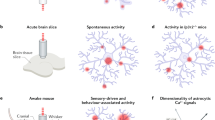Abstract
In the brain, astrocytes modulate the transfer of information between neurons at the level of the synapse. Following their activation via receptors during synaptic transmission, these glial cells encode and in turn regulate the efficacy of transmission through calcium-dependent mechanisms. Although astrocytes are the most numerous glial cells in the brain, other glial cell types are also present. Furthermore, astrocytes form an intricate and ramified morphological network with neurons. Hence, the study of the role of astrocytes in synaptic transmission requires the use of techniques allowing their specific loading with various compounds such as calcium indicators and drugs to respectively monitor and modulate their activity. Importantly, these techniques must permit the study of astrocyte activity in their processes, the location where the rapid and privileged interactions with synapses take place. In order to identify the astrocytes and introduce molecules specifically into them, we use the patch clamp recording technique in whole-cell configuration. Here we describe individual steps necessary to carry out patch-clamp recordings in parallel with calcium imaging at the level of astrocyte processes.
Access this chapter
Tax calculation will be finalised at checkout
Purchases are for personal use only
Similar content being viewed by others
References
Araque A, Parpura V, Sanzgiri RP, Haydon PG (1999) Tripartite synapses: glia, the unacknowledged partner. Trends Neurosci 22:208–215
Ventura R, Harris KM (1999) Three-dimensional relationships between hippocampal synapses and astrocytes. J Neurosci 19:6897–6906
Verkhratsky A, Orkand RK, Kettenmann H (1998) Glial calcium: homeostasis and signaling function. Physiol Rev 78:99–141
Pasti L, Volterra A, Pozzan T, Carmignoto G (1997) Intracellular calcium oscillations in astrocytes: a highly plastic, bidirectional form of communication between neurons and astrocytes in situ. J Neurosci 17:7817–7830
Porter JT, McCarthy KD (1996) Hippocampal astrocytes in situ respond to glutamate released from synaptic terminals. J Neurosci 16:5073–5081
Latour I, Gee CE, Robitaille R, Lacaille JC (2001) Differential mechanisms of Ca2+ responses in glial cells evoked by exogenous and endogenous glutamate in rat hippocampus. Hippocampus 11:132–145
Fellin T, Pascual O, Gobbo S, Pozzan T, Haydon PG, Carmignoto G (2004) Neuronal synchrony mediated by astrocytic glutamate through activation of extrasynaptic NMDA receptors. Neuron 43:729–743
Perea G, Araque A (2005) Properties of synaptically evoked astrocyte calcium signal reveal synaptic information processing by astrocytes. J Neurosci 25:2192–2203
Panatier A, Theodosis DT, Mothet J-P, Touquet B, Pollegioni L, Poulain DA, Oliet SHR (2006) Glia-derived D-serine controls NMDA receptor activity and synaptic memory. Cell 125:775–784
Pascual O, Casper KB, Kubera C, Zhang J, Revilla-Sanchez R, Sul J-Y, Takano H, Moss SJ, McCarthy K, Haydon PG (2005) Astrocytic purinergic signaling coordinates synaptic networks. Science 310:113–116
Serrano A, Haddjeri N, Lacaille J-C, Robitaille R (2006) Gabaergic network activation of glial cells underlies hippocampal heterosynaptic depression. J Neurosci 26:5370–5382
Halassa MM, Haydon PG (2010) Integrated brain circuits, astrocytic networks modulate neuronal activity and behavior. Annu Rev Physiol 72:335–355
Volterra A, Meldolesi J (2005) Astrocytes, from brain glue to communication elements. The revolution continues. Nat Rev Neurosci 6:626–640
D’Ambrosio R, Wenzel J, Schwartzkroin PA, McKhann GM, Janigro D (1998) Functional specialization and topographic segregation of hippocampal astrocytes. J Neurosci 18:4425–4438
Matthias K, Kirchhoff F, Seifert G, Hüttmann K, Matyash M, Kettenmann H, Steinhäuser C (2003) Segregated expression of AMPA-type glutamate receptors and glutamate transporters defines distinct astrocyte populations in the mouse hippocampus. J Neurosci 23:1750–1758
Serrano A, Robitaille R, Lacaille J-C (2008) Differential NMDA-dependent activation of glial cells in mouse hippocampus. Glia 56:1648–1663
Zhou M (2005) Development of GLAST(+) astrocytes and NG2(+) glia in rat hippocampus CA1: mature astrocytes are electrophysiologically passive. J Neurophysiol 95:134–143
Zhou W, Ge W-P, Zeng S, Duan S, Luo Q (2007) Identification and two-photon imaging of oligodendrocyte in CA1 region of hippocampal slices. Biochem Biophys Res Commun 352:598–602
Wallraff A, Odermatt B, Willecke K, Steinhäuser C (2004) Distinct types of astroglial cells in the hippocampus differ in gap junction coupling. Glia 48:36–43
Panatier A, Vallée J, Haber M, Murai KK, Lacaille JC, Robitaille R (2011) Astrocytes are endogenous regulators of basal transmission at central synapses. Cell 146:785–798
Paredes RM, Etzler JC, Watts LT, Zheng W, Lechleiter JD (2008) Chemical calcium indicators. Methods 46:143–151
Yasuda R, Nimchinsky EA, Scheuss V, Pologruto TA, Oertner TG, Sabatini BL, Svoboda K (2004) Imaging calcium concentration dynamics in small neuronal compartments. Sci STKE 2004:pl5
Author information
Authors and Affiliations
Editor information
Editors and Affiliations
Rights and permissions
Copyright information
© 2013 Springer Science+Business Media, LLC
About this protocol
Cite this protocol
Panatier, A., Robitaille, R. (2013). Intracellular Loading and Rapid Calcium Imaging in Processes of Hippocampal Astrocytes. In: Nguyen, P. (eds) Multidisciplinary Tools for Investigating Synaptic Plasticity. Neuromethods, vol 81. Humana Press, Totowa, NJ. https://doi.org/10.1007/978-1-62703-517-0_9
Download citation
DOI: https://doi.org/10.1007/978-1-62703-517-0_9
Published:
Publisher Name: Humana Press, Totowa, NJ
Print ISBN: 978-1-62703-516-3
Online ISBN: 978-1-62703-517-0
eBook Packages: Springer Protocols




